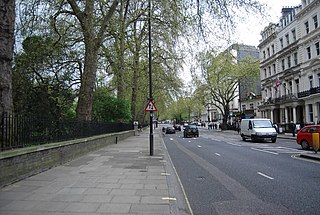
Bayswater is an area in the City of Westminster in West London. It is a built-up district with a population density of 17,500 per square kilometre, and is located between Kensington Gardens to the south, Paddington to the north-east, and Notting Hill to the west.

Harewood House is a country house in Harewood, West Yorkshire, England. Designed by architects John Carr and Robert Adam, it was built, between 1759 and 1771, for Edwin Lascelles, 1st Baron Harewood, a wealthy West Indian plantation and slave owner. The landscape was designed by Lancelot "Capability" Brown and spans 1,000 acres (400 ha) at Harewood.
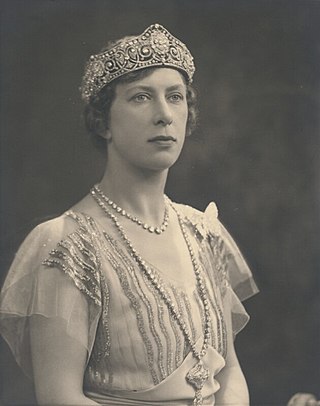
Mary, Princess Royal was a member of the British royal family. She was the only daughter of King George V and Queen Mary, the sister of kings Edward VIII and George VI, and aunt of Elizabeth II. In the First World War, she performed charity work in support of servicemen and their families. She married Henry Lascelles, Viscount Lascelles, in 1922. Mary was given the title of Princess Royal in 1932. During the Second World War, she was Controller Commandant of the Auxiliary Territorial Service. The Princess Royal and the Earl of Harewood had two sons, George Lascelles, 7th Earl of Harewood, and Gerald David Lascelles.
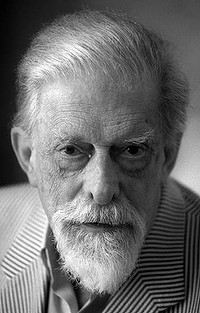
George Henry Hubert Lascelles, 7th Earl of Harewood, styled The Honourable George Lascelles before 1929 and Viscount Lascelles between 1929 and 1947, was a British classical music administrator and author, and an extended Member of the British Royal Family, as a maternal grandson of King George V and Queen Mary, and thus a first-cousin of Queen Elizabeth II. He served as director of the Royal Opera House, chairman of the board of the English National Opera (ENO) (1986–1995); managing director of the ENO (1972–1985), managing director of the English National Opera North (1978–81), governor of the BBC (1985–1987), and president of the British Board of Film Classification (1985–1996).

Belgravia is a district in Central London, covering parts of the areas of the City of Westminster and the Royal Borough of Kensington and Chelsea.

The Metropolitan Borough of Westminster was a metropolitan borough in the County of London, England, from 1900 to 1965.

Earl of Harewood, in the County of York, is a title in the Peerage of the United Kingdom.

Hanover Square is a green square in Mayfair, Westminster, south west of Oxford Circus where Oxford Street meets Regent Street. Six streets converge on the square which include Harewood Place with links to Oxford Street, Princes Street, Hanover Street, Saint George Street, Brook Street and Tenderden Street, linking to Bond Street and Oxford Street.

David Henry George Lascelles, 8th Earl of Harewood, styled as Viscount Lascelles until July 2011, is a British hereditary peer and film and television producer.

Bayswater Road is the main road running along the northern edge of Hyde Park in London. Originally part of the A40 road, it is now designated part of the A402 road.

Lancaster Gate is a mid-19th century development in the Bayswater district of central London, immediately to the north of Kensington Gardens.
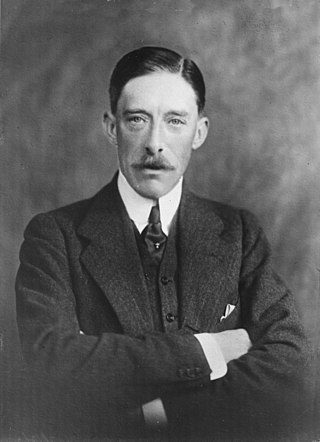
Henry George Charles Lascelles, 6th Earl of Harewood, known by the courtesy title of Viscount Lascelles until 1929, was a British soldier and peer. He was the husband of Mary, Princess Royal, and thus a son-in-law of King George V and Queen Mary and a brother-in-law to kings Edward VIII and George VI.

Maria Donata Nanetta Paulina Gustava Erwina Wilhelmine Stein, known as Marion Stein, was an Austrian-born British concert pianist. During her marriage to George Lascelles, Earl of Harewood, she was known as Marion Lascelles, Countess of Harewood and was a member of the British Royal family. After her divorce and subsequent remarriage to British politician Jeremy Thorpe, leader of the Liberal Party from 1967 to 1976, she became known as Marion Thorpe.
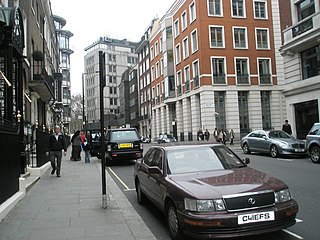
Curzon Street is a street in Mayfair, London, within the W1J postcode district, that ranges from Fitzmaurice Place, past Shepherd Market, to Park Lane. It is named after Sir Nathaniel Curzon, 2nd Baronet, who inherited the landholding during 1715. More houses were built there during the 1720s.

Campden Hill is a hill in Kensington, West London, bounded by Holland Park Avenue on the north, Kensington High Street on the south, Kensington Palace Gardens on the east and Abbotsbury Road on the west. The name derives from the former Campden House, built by Baptist Hicks, 1st Viscount Campden whose country seat was Campden House in the Gloucestershire town of Chipping Campden.

Goldsborough Hall is a Jacobean stately home located in the village of Goldsborough, North Yorkshire, England. It is a member of the Historic Houses Association. The house itself is a Grade II* listed building. The Hall was built for Sir Richard Hutton (1560–1639) after he acquired the Goldsborough Estate in 1598, and in the 20th century it was home to Princess Mary, Countess of Harewood as her first family home.

Onslow Square is a garden square in South Kensington, London, England.
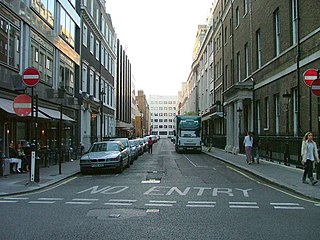
Old Burlington Street is a street in central London that is on land that was once part of the Burlington Estate.
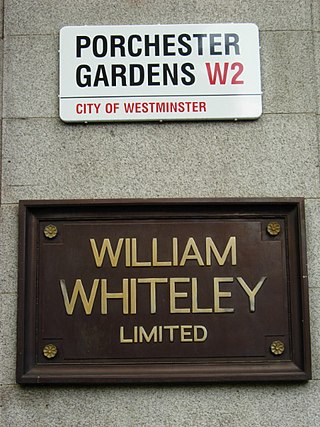
Porchester Gardens is a street in the Bayswater area of London. Located in the City of Westminster, it runs east to west and crosses Queensway. Like several streets in the area it was developed by Edward Orme. In 1879 the engineer R. E. B. Crompton lit his house by electricity, effectively the first in London to do so. The department store Whiteleys was located where the two streets joined before its closure. The road features a mixture of residential and commercial properties. At the eastern end, Porchester Terrace runs southwards to Kensington Gardens while in the west it ultimately merges into Kensington Gardens Square and Leinster Square. Moscow Road runs parallel to the south for much of the route.
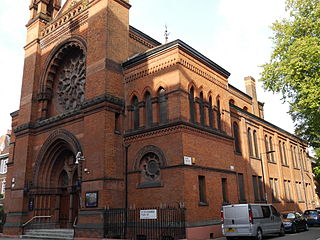
St Petersburgh Place is a street in the Bayswater area of London, located in the City of Westminster. It runs north to south from Moscow Road to Bayswater Road, close to the northwestern entrance to Kensington Gardens. It was constructed by the property developer and painter Edward Orme during the Regency. As with Moscow Road its name commemorates the visit of Alexander I of Russia to London in 1814 as part of the Allied celebrations following the victory in the Napoleonic Wars. It was originally known simply as Petersburgh Place, but this was later changed to St Petersburgh Place, an alternative spelling of Saint Petersburg, the then-capital of the Russian Empire. In 1818 Orme constructed a Bayswater Chapel for the growing number of inhabitants. From 1823 to 1826 Orme also developed the nearby Orme Square. Adjacent to the street is the smaller St Petersburgh Mews, which runs parallel northwards to Moscow Road.




















